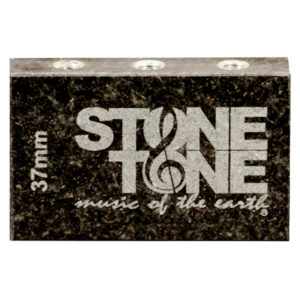Sustain Blocks, Vol.1: Brass and Titanium

Sustain block upgrades have been going on for at least 6-7 years now. I’m not clear when some of the makers of tremolos opted for savings over quality, but I’d figure there might be a correlation between the decline in quality and the appearance of options. So then, let’s say you have a double locking trem…. be it a Floyd Rose or an Ibanez Edge or a Schaller or a Gotoh or whatever… depending on which one, you might have brass or nickel-covered brass or cheap pot metal or whatever else might have been used by whatever place made the one you have.
But, you say, my Gotoh has a brass block! Then cool! Can it hold a bigger block? Or have you tried titanium?
First off… a bigger block? Well, yeah, size can matter. You can look at the thickness of the block and the length of the block. How thick is right for you? That’s up to you. Consider how you use your trem and how much space you need for it. I’ve heard about 3/4″ thick blocks being used. That’s pretty big! It will also greatly reduce the amount of travel on your dive bombs. How long is right for you? Well, some places just take the trem as it comes to them and install it as it is. You might get a trem with a 32MM block where a 37MM or a 42MM might fit better.
Before I forget, I do see players that can make assumptions about what size block they need: “I have a recessed trem so I need a 32MM.” Dude, come on… get off your butt and get out the ruler and get the measurement. Sure, some recessed trems might only take 32MM. I have them that take 37MM and 42MM. Don’t make an assumption because it’s easier than finding out for certain.
Something that’s not an assumption is how thick do I need. This one can be rough. Not every guitar out there can handle the 1/2″ thick blocks. Depending on how it’s been routed, some can have a limited amount of space. Sometimes it can be the opening in the top of the guitar and sometimes it can be the amount routed out of the trem cavity. Sometimes it can be a few minutes with the routing attachment on your Dremel and sometimes it’s not worth carving up your guitar.
Anyway… on to the difference in the metals. Both will give you more sustain, so let’s get that out of the way. How about the tone?
You want richer? Go with brass. You want more transparency? Go with titanium.

Brass has gotten really popular and more and more players have become familiar with the affect it has. Brass is clearly a musical metal. That’s why you have a brass section in bands and orchestras. Brass delivers a richness. Not thicker and not heavier, but richer. Bigger and fuller might also apply, but don’t confuse it with thick and heavy. Brass can be very easy to get your hands on too, in case you needed some for any DIY projects you may have going on. By visiting somewhere similar to Aluminium Warehouse (www.aluminiumwarehouse.co.uk/brass/sheet), they can ensure that you pick the best type and size of brass sheet from their many different metal products. Brass is a great way to go and I have far more brass in my guitars than titanium, so I’d never steer anyone away from brass. And it’s cost effective in relation to the benefit. You can get a new brass block for less than $30 shipped these days… if you can’t handle $30, you have the wrong hobby. lol!
Speaking of brass…. how about a brass alloy locking nut (see photo – go ahead, you can click)?
Titanium can get a bad rap because it cost a little more and your typical guitar player is always watching their wallet. Some people claim that it’s brighter. I think it’s a matter of clarity. When it’s more clear, you get more string separation and more transparency, so it might seem like it’s brighter. What’s really happening is that the transparency of the titanium is letting more of the what’s really going on come through. Was that cheap pot metal block dulling your sound and you countered by putting a really bright pickup in there? …removing the cause of the dullness opened things up and your pickup selection might be too bright after all – that’s just an example and not the rule. Even if you get titanium in the standard original block thickness, you will be able to hear the benefits.

Who has the best brass or titanium sustain blocks? Lemme tell ya, daddy-o, I have stuff from a few different places. I’m hard pressed to hear a difference in tone. Even if there were, tone is subjective and whatever sounds good to you is good for you. This is one of those things that can come down to cost and how you feel about the providers.
All things being equal, I’d genuinely like to compare the same item across many brands. And that will lead us in to the upcoming Vol.2 of Sustain Blocks, where we will have a conversation dedicated to granite sustain blocks made by Stone Tone. Stone Tone agreed to send out a sample in a Floyd Rose size and configuration suitable to do direct comparisons to both brass and titanium sustain blocks in the same guitars. Stay tuned!




